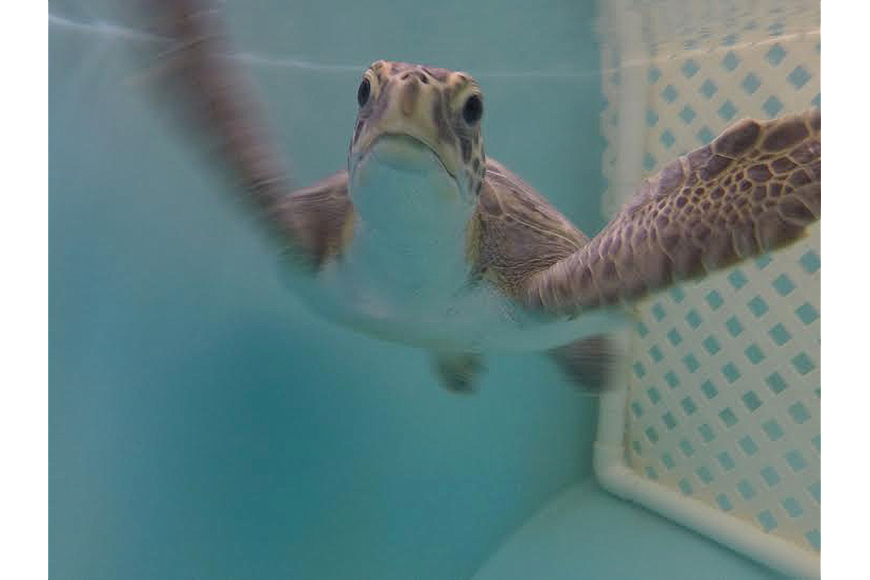- April 19, 2024
-
-
Loading

Loading

Turtle nesting season officially starts May 1, and that means hundreds of sea turtles will be emerging from the surf at night to lay eggs on the beach during the next few months.
According to a press release from Volusia County, after incubating in the sand for about two months, each nest — which containing about 100 eggs — will hatch and the baby turtles will make an often-treacherous crawl to the ocean, dodging predators, holes, trash, vehicle ruts and beach furniture. Tragically, some will be led into harm’s way by beachfront lighting.
It’s estimated that only about one in 1,000 to 10,000 hatchlings will make it safely to sexual maturity, which is at about 25 to 30 years of age. Jennifer Winters, Volusia County's sea turtle Habitat Conservation Plan program manager, wants to improve those odds.
“We need everybody’s help to make this a safe and productive nesting season,” she said in a press release. “We encourage residents and visitors to play safely, protect wildlife and respect the beach. That includes letting only the natural moonlight provide the light at night.”
Since Hurricane Matthew caused extensive damage and beach erosion last October, the beach has been rebuilding sand and is growing back on its own at a fast pace. Volusia County has managed extensive debris removal
efforts and repair and replacement of public infrastructure along the beach. However, some damaged and discarded property from private properties has not been picked up and is being buried in the sand where it is at risk of becoming an obstacle to sea turtles attempting to dig in the sand to lay their eggs.
If these objects are encountered, sea turtles may abandon their nesting attempts and return to the ocean without making a nest.
It is important beachfront property owners get involved with making the beach a safer place now, by removing any structure that is no longer functional from the beach area. This may include old sand fencing posts, broken pieces of concrete from retaining walls, sand bags and any other temporary means of shoreline protection or abandoned structures.
Beachfront property owners also should inspect their property from the beach at night to look for lighting that may need adjustment and correct the lighting prior to May 1 – when proactive lighting enforcement efforts will begin.
“Artificial lighting is a human-made threat we can correct with minimal effort,” Winters said. “Bright lights can prevent females from nesting, and they can confuse hatchlings – leading them away from the ocean and into the streets or storm drains. By simply shielding or redirecting lights away from the beach and turning them off when not in use, beachfront residents can help sea turtles survive.”
During nesting season, residents are required to comply with the sea turtle lighting ordinance by making sure lights don’t shine on the beach.
Shorebird nesting season is also underway. Between March and August, some species of birds will make a small scrape on top of the sand and lay their eggs directly on the sand, usually in the upper portion of beach near the dunes or seawall.
Pairs of birds will take turns incubating the eggs for about 30 days until they hatch, at which time the young flightless chicks are vulnerable to a number of things, including predators, vehicles and exposure if they do not have a safe place to rest and are frequently disturbed.
While shorebird nesting sites are rare in Volusia, in recent years, nesting areas have been found near Bethune Beachfront Park, Smyrna Dunes Park, Disappearing Island, and on sand and oyster bars along the Halifax
River. If you notice birds becoming loud and aggressive while at the beach, please move away, avoid feeding them and view them from a distance.
Known nesting areas are posted with signs to notify beach users of the nest sites.
Residents and visitors can also help sea turtles and shorebirds by following these tips while using the beach:
If an animal appears to be in immediate danger, notify a lifeguard or beach safety officer or call the Florida Fish and Wildlife Conservation Commission at 888-404-3922.
During an average year, 400 to 500 nests are laid in Volusia County. Last year’s count, the third highest on record, was 676 nests. They were laid by 666 loggerheads, four green sea turtles, five leatherbacks and one Kemp’s ridley.
For more information about Volusia County’s sea turtle and habitat conservation plan program, visit www.volusiaseaturtles.org or call 238-4668. For questions about the lighting ordinance, call 238-4773.